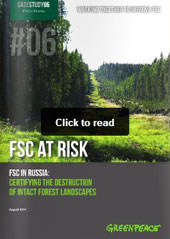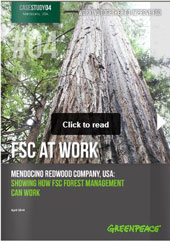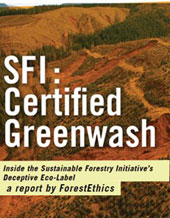FSC at risk – PEFC at peace?
Over the past year, Greenpeace has stepped up its public scrutiny of the FSC system. This might lead some industries, particularly in Europe, to see PEFC as the safer choice in terms of avoiding the NGO spotlight. However, this could prove to be an illusion.
 One of FSC’s biggest strengths is the support of leading international environmental NGOs such as Greenpeace and WWF. The strong involvement of NGOs also leads to high expectations for the system’s performance on the ground, laying the ground for fierce debates.
One of FSC’s biggest strengths is the support of leading international environmental NGOs such as Greenpeace and WWF. The strong involvement of NGOs also leads to high expectations for the system’s performance on the ground, laying the ground for fierce debates.
Greenpeace is an active member and supporter of the FSC system, however the last couple of years have seen the launch of several critical Greenpeace reports spotlighting perceived faults and weaknesses of the FSC system. Using the tagline “FSC at risk”, the organisation puts several specific forest operations and companies in the dock, accusing them of violating the FSC spirit or requirements.
This situation adds to industry concerns over FSC’s frequent system changes, often with short deadlines that leave companies little time to adapt.
Some FSC supporters now fear that this may create a relative advantage for the world’s other major forestry eco-labelling scheme, PEFC, for example in Europe and Asia where NGOs tend to ignore PEFC or PEFC-endorsed schemes.
Many public procurement policies recognise both FSC and PEFC certification with no preference for one over the other. Do industries have reason to see PEFC as the safer choice when they are looking for a stable and reliable solution to responsible wood sourcing?
From Greenpeace with tough love
 We asked Greenpeace forest campaigner Judy Rodrigues if Greenpeace is aware of the impact that their allegations against FSC and in particular against specific companies can have on the relative success of FSC and PEFC.
We asked Greenpeace forest campaigner Judy Rodrigues if Greenpeace is aware of the impact that their allegations against FSC and in particular against specific companies can have on the relative success of FSC and PEFC.
“We have recently become more public and vocal about our concerns over the FSC system”, she concedes. “After having voiced our concerns directly with FSC and using the system’s formal processes for a long time, we felt that progress was too slow. That’s why we’ve taken a ‘tough love’ approach”.
She stresses that Greenpeace has balanced its criticism by publishing examples of ‘FSC at work’ as well: “We’re pushing for improvements of the FSC system by spotlighting bad as well as good cases”.
Ms Rodrigues also underlines that Greenpeace remains very sceptical of the PEFC scheme.
“I don’t consider any of their labels and standards as credible. PEFC’s rules are wide open to interpretation and the general impression is that it’s still dominated by the industry. Even though they’ve tried to engage stakeholders in recent years, history has built an air of distrust. Most of us in the NGO community remain untrusting of the system until there’s proof in the pudding that it’s working in a transparent and credible way”, she says.
“Currently we’re using our resources to strengthen the FSC system. However, we are alert to the fact that fake schemes may be gaining ground. In terms of risk, companies shouldn’t be naïve and lull themselves into a false sense of security with regard to PEFC”.
North America: NGOs are campaigning for FSC

Whilst European companies may feel that there is comparatively more scrutiny of FSC compared to PEFC, the picture looks quite different in the US according to Sierra Club campaigner and co-founder of Greenwash Action Jason Grant.
Several North American NGOs are campaigning vigorously against the PEFC-endorsed US scheme Sustainable Forestry Initiative (SFI).
“These campaigns are part of a larger battle surrounding green building in the US”, he explains. The US Green Building Council’s LEED scheme only gives credit to FSC certified wood materials.This has led the industry to create a competing green building certification system, GreenGlobes, which recognises SFI certified material as well.
Mr Grant also points towards the Environmental Paper Network – a coalition of leading NGOs – that promotes FSC as the sole responsible source for virgin fibre.
Campaigner Jim Ace of the US organisation Forest Ethics says: “The SFI eco label is one of the most sophisticated and misleading green scams in North America. The SFI has repeatedly attempted to out-manoeuver and out-market the green seal of FSC which adheres to higher standards of environmental and social responsibility - while SFI puts a green stamp on wood and paper products linked to indiscriminate logging and business-as-usual industrial forestry practices”.
This perception has led Forest Ethics to engage in an on-going campaign against the SFI scheme.
Mr Ace: “Stretching from coast to coast, America’s natural forests are a global treasure and conserving them is a top priority for environmental movements. The more we expose SFI as the cynical greenwash scheme it is, the more we undermine SFI’s usefulness as a marketing tool for the timber industry, and the more pressure we exert on the industry to act responsibly”.

According to Mr Ace, the campaigns have had a clear effect: “US businesses and industries that use paper and fibre from trees know that they put their brand at risk by promoting and taking environmental credit for the timber industry’s misleading SFI forest certification programme and eco-label. To avoid that risk and align their business practices with their environmental values, we encourage companies to make a public commitment not to promote SFI. At this point, 25 major brands have made commitments to avoid the promotion of SFI”.
Mr Ace asserts that “most [US] businesses now see FSC as the only credible forest certification program, despite SFI’s and the timber industry’s efforts to equate SFI and FSC”.



